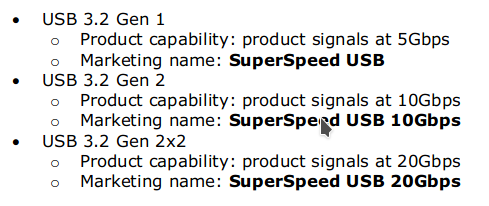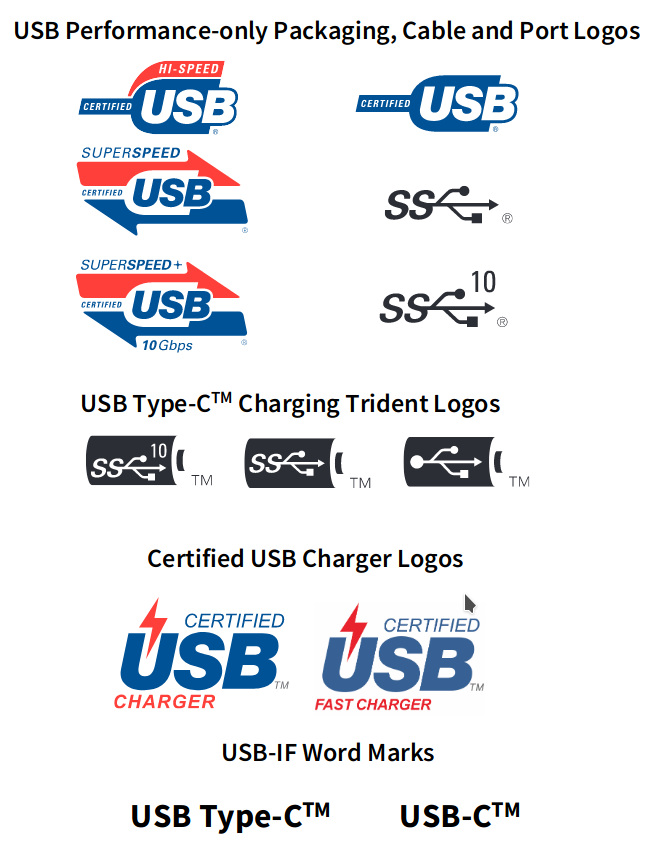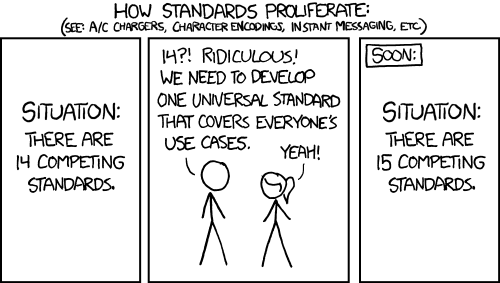This past week at MWC 2019 the USB Implementation Forum (USB-IF) announced the release of the USB 3.2 specification, which tacks on another level of speed to the existing USB 3.0 specification. And when I say “tack on”, I really mean tack on. USB 3.2 is basically two USB 3.1 Gen 2 ports that were smashed together to push twice the bandwidth of USB 3.1 Gen 2 over the same cable. But that’s the boring part of this announcement – what you need to pay attention to is the hilarious and confusing naming scheme the USB-IF has come up with.

To recap, USB 3.0 is the baseline specification, using primarily USB-A and USB-B connectors and ports, and capable of carrying a 5Gibps signal. USB 3.1 Gen 1 was introduced later on and brought with it a speed boost to 10Gibps and the versatile Type-C port, which allowed you to plug it in first time, every time.
Already the standard was confusing to explain to anyone who cared, because USB 3.1 Gen 1 products were typically using USB-A and Type-C ports, but a Type-C connector didn’t always indicate that it was a USB 3.1 Gen 1 port or that it could power anything of note. At this point, both USB 3.0 and USB 3.1 Gen 1 consumed one lane of PCIe connectivity.
This year the USB-IF decided to introduce USB 3.2. This was previously going to be called USB 3.1 Gen 2, but common sense prevailed and a simpler naming scheme was chosen. However, it seems that whichever intern decided to simplify the naming scheme didn’t last long because the USB-IF then began giving existing standards multiple new titles to further muddy the waters.

The USB 3.2 standard now includes all previous USB 3.x standards under a single standard, USB 3.2. It then splits USB 3.2 up into Gen 1, Gen 2, and not Gen 3 as you’d expect but “Gen 2×2”. Somehow being twice as fast isn’t enough to call it Gen 3. Gen 2×2 consumes two lanes of PCIe connectivity from the chipset inside your processor, which is how it’s able to drive twice the amount of available bandwidth. Then there are the new marketing names; SuperSpeed USB, SuperSpeed USB 10Gbps, and SuperSpeed USB 20Gbps.
So in the future you’ll see product boxes that say “SuperSpeed USB 20Gbps with Type-C”. This doesn’t really tell you everything about the product, however, because the Type-C standard will limit how much power you can feed through the port and cable, and a separate standard called USB Power Delivery dictates that (and has its own marketing guidelines to boot!).

While SuperSpeed USB 20Gbps ports are backwards compatible with SuperSpeed USB and USB 10Gbps devices, using a SuperSpeed USB 20Gbps connection requires a new, separately certified SuperSpeed USB 20Gbps cable.
Despite the USB-IF trying to simplify their messaging, what they’ve really done is create another separate standard that still doesn’t collect all the related standards under a simple marketing banner. Changing the name to SuperSpeed USB 20Gbps hasn’t really helped matters, but at least I don’t have to explain what “USB 3.2 Gen 2×2” means to my mom.

Last Updated: February 28, 2019






















Admiral Chief
February 28, 2019 at 09:36
https://thumbs.gfycat.com/ClosedSimilarArcticduck-size_restricted.gif
Umar
February 28, 2019 at 09:36
Kingdom Hearts, is that you?
Admiral Chief
February 28, 2019 at 09:36
https://gifimage.net/wp-content/uploads/2018/11/confused-screaming-gif-2.gif
Admiral Chief
February 28, 2019 at 09:36
https://media.giphy.com/media/1X7lCRp8iE0yrdZvwd/giphy.gif
Guz
February 28, 2019 at 10:02
My brain hurts……
Admiral Chief
February 28, 2019 at 10:17
This is more confusing than understanding women
Guz
February 28, 2019 at 10:31
Its easier now, now you don’t have to worry which way you insert it.
Admiral Chief
February 28, 2019 at 13:05
[must not giggle]
Pariah
February 28, 2019 at 09:50
That comic really does highlight the irony of the “Universal” in USB. More like UBS.
Gavin Mannion
February 28, 2019 at 10:03
https://cdn.shopify.com/s/files/1/1111/4912/products/Mugatu-Crazy-Pills_large.jpg?v=1539881493
HvR
February 28, 2019 at 11:58
The only thing confusing here is whoever wrote this article getting very incorrect mixing different specification into one in some cases and splitting single standard into different ones in other cases. To his defense so does most of the articles out there.
In short nothing major has changed, USB always made up out of 3 separate specifications because they are aimed at 3 different manufacturing industries.
Data transfer specification (of which the new one is USB 3.2)
Port standard (Of which the latest is type C, type A superspeed and type B superspeed)
Power transfer specification (which are normally coupled to the port standard, but can branch out to low and a high power)
You always had to match the port type and standard, data transfer and power transfer only became important if wanted max performance as they always (thank IEEE gods) stayed backwards compatible. This has been the case since the mid 90’s
Why Gen 2 x 2 and not Gen 3; there is zero difference electrical and encoding within the specification it merely uses the dual lanes provides by the type C port standard. The specification name is meant for for people in the industry not the consumer.
SO TLDR yes
SuperSpeed (SS)
SuperSpeed 10 (SS10)
Superspeed 20 (SS20)
is a lot simpler than
remembering what speed is high speed and high speed+ what is gen 1 what is gen 2 is USB 3.1 gen 1 the same as USB 3.0 etc
Guz
February 28, 2019 at 12:12
Wow thanks, that actually clears it up quite a bit
MaSeKind
February 28, 2019 at 12:41
HA! Jokes on you mate. I’m already confused AF